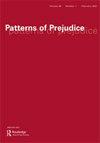‘I feel like Sophie Scholl’: the (mis)appropriation of icons of anti-Nazi resistance in contemporary Germany
IF 0.8
2区 社会学
Q4 ETHNIC STUDIES
引用次数: 0
Abstract
ABSTRACT Germany’s Covid-19 protesters and members of the far right have tried to appropriate two key historical figures associated with the German anti-Nazi resistance, Sophie Scholl (1921–1943), who distributed anti-government leaflets, and Claus Schenk Graf von Stauffenberg (1907–1944), the mastermind of the failed coup of 20 July 1944. Neumann places these attempts in the context of the afterlives of Scholl, Stauffenberg and aspiring Hitler assassin Georg Elser (1903–1945). First, he argues that the far right’s attempt to claim Stauffenberg should not be read as a move to deny the Holocaust, nor to reject Germany’s responsibility for it, but rather to distance itself from Holocaust deniers and shift public discourses about German identity and history. Second, he argues that Covid-19 protesters have identified with Scholl because she has been considered the quintessential ‘good German’, she cannot be located on a left–right political spectrum and she represents German resistance as well as victimhood. Finally, he suggests that the success of these attempts to appropriate historical figures points to a lack of knowledge not about Nazi Germany’s victims, or about Scholl and Stauffenberg themselves, but rather about the nature of the Nazi regime.“我觉得自己像索菲·肖尔”:当代德国反纳粹抵抗运动的偶像(错误地)挪用
摘要德国新冠肺炎抗议者和极右翼成员试图抓住与德国反纳粹抵抗有关的两位关键历史人物,即散发反政府传单的Sophie Scholl(1921–1943)和1944年7月20日失败政变的主谋Claus Schenk Graf von Stauffenberg(1907–1944)。诺依曼将这些尝试置于朔尔、施陶芬贝格和有抱负的希特勒暗杀者格奥尔格·埃尔瑟(1903-1945)的余生背景下。首先,他认为,极右翼试图宣称施陶芬贝格不应被解读为否认大屠杀,也不应拒绝德国对大屠杀的责任,而应与否认大屠杀的人保持距离,并改变公众对德国身份和历史的讨论。其次,他认为,新冠肺炎抗议者之所以认同Scholl,是因为她被认为是典型的“好德国人”,她不属于左右政治光谱,她代表了德国的抵抗和受害者身份。最后,他认为,这些试图塑造历史人物的成功表明,人们并不了解纳粹德国的受害者,也不了解朔尔和施陶芬贝格本人,而是对纳粹政权的性质缺乏了解。
本文章由计算机程序翻译,如有差异,请以英文原文为准。
求助全文
约1分钟内获得全文
求助全文
来源期刊

Patterns of Prejudice
Multiple-
CiteScore
2.50
自引率
0.00%
发文量
11
期刊介绍:
Patterns of Prejudice provides a forum for exploring the historical roots and contemporary varieties of social exclusion and the demonization or stigmatisation of the Other. It probes the language and construction of "race", nation, colour, and ethnicity, as well as the linkages between these categories. It encourages discussion of issues at the top of the public policy agenda, such as asylum, immigration, hate crimes and citizenship. As none of these issues are confined to any one region, Patterns of Prejudice maintains a global optic, at the same time as scrutinizing intensely the history and development of intolerance and chauvinism in the United States and Europe, both East and West.
 求助内容:
求助内容: 应助结果提醒方式:
应助结果提醒方式:


